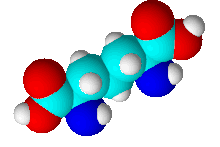Diaminopimelic acid (DAP) is an amino acid, representing an epsilon-carboxy derivative of lysine. meso-α,ε-Diaminopimelic acid is the last intermediate in the biosynthesis of lysine and undergoes decarboxylation by diaminopimelate decarboxylase to give the final product.[1]

| |

| |
| Names | |
|---|---|
| Preferred IUPAC name
(2R,6S)-2,6-Diaminoheptanedioic acid | |
| Identifiers | |
3D model (JSmol)
|
|
| ChEBI | |
| ChEMBL | |
| ChemSpider | |
| ECHA InfoCard | 100.008.660 |
| MeSH | Diaminopimelic+acid |
PubChem CID
|
|
| UNII | |
CompTox Dashboard (EPA)
|
|
| |
| |
| Properties | |
| C7H14N2O4 | |
| Molar mass | 190.20 g/mol |
| Appearance | white powder |
| Density | 1.344 g/mL |
| Melting point | 295 °C (563 °F; 568 K) |
| Boiling point | 426.7 °C (800.1 °F; 699.8 K) |
| Hazards | |
| Occupational safety and health (OHS/OSH): | |
Main hazards
|
Irritant |
Except where otherwise noted, data are given for materials in their standard state (at 25 °C [77 °F], 100 kPa).
| |
DAP is a characteristic of certain cell walls[2] of some bacteria. DAP is often found in the peptide linkages of NAM-NAG chains that make up the cell wall of gram-negative bacteria. When provided, they exhibit normal growth. When in deficiency, they still grow but with the inability to make new cell wall peptidoglycan.
This is also the attachment point for Braun's lipoprotein.[3]
See also
edit- Aspartate-semialdehyde dehydrogenase, an enzyme involved in DAP synthesis
- Peptidoglycan
- Pimelic acid
Images
editReferences
edit- ^ Voet, Donald; Voet, Judith G. (2011). Biochemistry (4th ed.). Hoboken, NJ: John Wiley & Sons. pp. 1072–1075. ISBN 978-0-470-57095-1. OCLC 690489261.
- ^ Brooks, George H.; Geo F. Brooks (2007). Jawetz, Melnick & Adelberg's medical microbiology. McGraw-Hill Medical. pp. 85. ISBN 978-0-07-147666-9.
- ^ Seltmann, Guntram; Holst, Otto (2002). The Bacterial Cell Wall. Berlin: Springer. pp. 81–82. ISBN 3-540-42608-6.